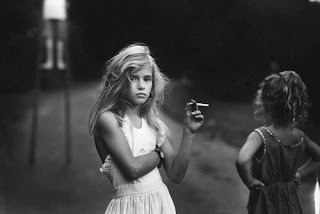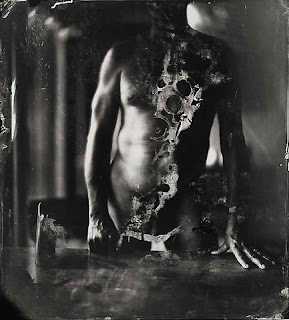Georgia and I met on Friday one last time before she goes off to the sun and surf of California for the winter. Because it was our final get together we chose carefully: Nancy Spero and Aman at the Pompidou Centre. While we bemoaned the vacuity of Aman’s work and the small range of the Spero’s on exhibition, sipping our tea, I started folding the Pompidou’s “what’s on today” sheet and suddenly realized that we were perfectly timed for the opening of the latest Ryoji Ikeda installation, data.matrix[no.1-10], 2010. And so we rushed downstairs for what I knew would be an unforgettable experience.
Ikeda’s work is the closest thing I know to brilliance. In fact his work is so haunting, mesmerizing, hypnotic, challenging in every way — physically, emotionally, spiritually — that I can never do justice to it in writing. If you only go to see one piece of art this year, Data.matrix [no.1-10] has to be it.
 |
| datamatics [prototype-ver.2.0] |
Apparently Ikeda is a composer, but he could just as easily be an engineer, a computer programmer, a filmmaker, a mathematician, a physicist, an architect or a philosopher. His electronic and digital sound-image installations and environments are so expansive, so complex that they not only engage us on every level, demanding activation of all our senses, our minds, our instincts, but they also embrace every form of epistemology, and every form of communication. It is difficult to capture data.matrix [no.1-10] in words because its uniqueness demands a whole new language. I don’t fully understand Ikeda’s work. Not only because the acoustic and visual environment is beyond human time and space, but I am not a sound technician, neither am I a physicist, a mathematician, a computer programmer or an engineer. And my guess is that if I were, I still wouldn’t understand because I am not a filmmaker, or a musician. In the same way that the data that produces the lines, patterns, scenes and sounds is motivated by a logic of aleatory proliferation and sequencing, so the audio visual construction is infinite and always unknown. And yet, while this is conceptual art at its most cerebral, Ikeda’s installation is also inviting, seductive, sensuous, and it echoes my desire.
 |
| data.matrix[no.1-10] |
My first response is one of wonder at the persistence of vision I experience as I focus on one screen and its rapidly changing “images.” Bursts of color appear, indeterminate, as I continue to stare at white on black that is really on the screen. I struggle to find familiarity. The sound reminds me of that distinctive clicking of the train timetables in European stations as one train departs and all the others move up a notch on the schedule. And I think of Las Vegas, of the eternal spin of the roulette wheel with a clicking sound that is so addictive, so filled with expectation and carries in it the promise of disappointment. The infinite and constant stream of undecipherable numbers on one screen reminds me of the stock exchange, and I watch hypnotized by the rhythms and the beat of the images as they proceed like a LED light display, only faster to the point of imperceptibility. My only reassurance is that sound and image are synchronized, as far as I can tell.
And then when both image and sound disintegrate into white or black, static, all at once, I know there is some power behind them, too immense for me to imagine. Perhaps this is the power of mathematics looking to understand the universe? The screens explode in synchonization. And then it all starts over again. Something is repeated. But it is not repeated in the sense of the same: This is repetition where there is no original, no telos, and every iteration is in search of these non-existent end points. The mathematical precision that energizes this other world is again inexplicable because if the secret were known, cognizeable, no limits would be challenged, in fact everything would take place in the realms of human time and space.
Data.matrix [no.1-10] is, as I say, visually entrancing: mesmerized, I cannot take my eyes off it. And the sounds, the rhythm of the beeping, the ticking, the otherwordly chimes, are hypnotic. And so, this highly intellectual and cerebral exercise seduces me. With my constant search to control and to know it, I am reminded of Peter Kubelka’ Arnulf Rainer or a Tony Conrad flicker film. These ten screens like structural film, though in a whole new medium, or concert of media, are light reduced, and elevated to image such that it is the substance of what our eyes behold. And then there is the acoustic environment I cannot account for.
 |
| data.matrix[no.1-10] |
As Georgia pointed out Data.matrix [no.1-10], is also clean, free of the messiness of the human body. It might be all about perception, audition, desire, seduction, and the sheer density of emotions. But, in a characteristic, I want to say, typically Japanese way, it is also slick and with no trace of the clinical. Yet another characteristic that makes Ikeda’s work unfathomable. This is what makes all other art in its midst pale by comparison. Data.matrix [no.1-10] is beyond the constraints of the body, constraints not only imposed by the physicality and substance, the material of human flesh, but, as I say, the constraints of time and space as we know and imagine them have been disintegrated and left behind.
All images copyright Ryoji Ikeda



























+by+Gabriel+Orozco+from+the+Mobile+Matrix+installation+at+the+MoMA_thumb%5B5%5D.jpg)



